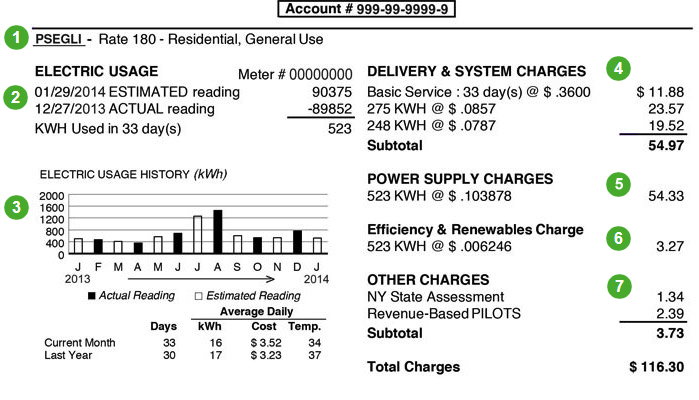Understanding your bill with PSEG Long Island in New York State

This page describes an example of a PSEG Long Island typical bill, a definition of each term and its purpose in your bill.
How to Save Money on Your PSEG Long Island bill
Electricity prices are rising each year, so here are a few ideas for taking the pressure off your energy budget.
The most effective change you can make is to reduce your overall energy consumption. A lot of the items on your PSEG Long Island bill are charged on a per kWh basis, so improving your energy efficiency at home can go a long way towards lowering your bills.
Energy Saving Ideas Check out some of our useful tips about how to save money on your energy bills, including how to save money in the summer, how to use your appliances wisely, and all about a little thing called vampire energy
Another option you can take is to take a look at the rate you're paying with PSEG Long Island, and see if it can be beat by an alternate energy supply company (ESCO). With electricity markets in New York open to competition, many alternative suppliers can offer competitive rates for electricity and natural gas.
To learn more about energy supply options in your area, check out our pages on energy in New York, or call us directly at phone currently not available to find the best rates in your area.
Example of a PSEG Long Island bill - page 1
Account information
This section includes your account number, and your rate type. It is important to verify that this information is correct on each bill that you receive, so that you know that you are being billed accurately.
Electric Usage
This includes information about your electricity use over the previous month, including the previous month's meter reading, the last meter reading, and the number of days and kWh consumed in that time.
Electric Usage History (kWh)
This graph will allow you to compare your consumption during all the months of the year, in order to better organize your usage. There are two types of meter readings: "actual" meter reading, and "estimated" meter reading. An estimated reading is based on the amount of energy used for a similar period the previous year. An actual reading happens when a PSEG Long Island meter reader comes and reads your meter. Any difference between the actual and the estimated use is corrected the next time the meter reader comes to reads the meter.
Delivery & System Charges
Basic service: The basic service charge is a fixed amount, which you pay no matter how much you consume. It exists to pay for basic maintenance of the systems, and for your bi-monthly meter reading. In most utilities, the basic service in fixed every month. Here it is almost the same thing, as the basic service is a fixed amount per day.
Delivery charge: This is a charge per kWh, which pays for the maintenance of the grid used to transmit and distribute the electricity to your home. Here, the first 275 kWh of usage are charged a certain amount (8.57¢/kWh). The next 248 kWh of electricity are charged slightly less (7.87¢/kWh).
Power Supply Charges
The power supply charges passes along the cost of purchasing energy on your behalf.
Efficiency & Renewable Charge
This includes the Renewable Portfolio Standard (RPS), which pays for renewable goals set by New York State. It also includes the System Benefits Charge, which supports energy efficiency initiatives, education and outreach, R&D, and energy assistance for people with low-income.
Other Charges
NY State Assessment: This tax is a special state assessment, collected by utilities for the New York State's general fund.
Revenue-Based PILOTS: Payments In Lieu Of Taxes: Payments that the Authority makes to other governmental authorities in replacement of the taxes which were previously collected on utility revenues, assets or operations. This includes the Gross Receipts Tax (GRT), which is taken by the state directly from the seller, PSEG Long Island, as a percentage of its revenues. PSEG Long Island then charges you for the payment of this tax.
